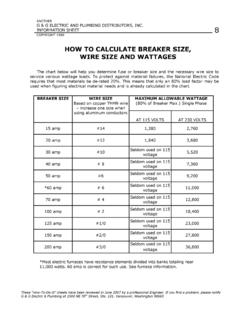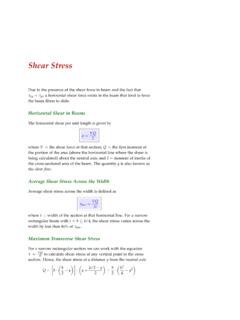Transcription of Chapter 2 The Maximum Likelihood Estimator
1 Chapter 2. The Maximum Likelihood Estimator We start this Chapter with a few quirky examples , based on estimators we are already familiar with and then we consider classical Maximum Likelihood estimation. Some examples of estimators Example 1. Let us suppose that {Xi }ni=1 are iid normal random variables with mean and variance 2 . P. The best estimators unbiased estimators of the mean and variance are X = n1 ni=1 Xi P P P 2. and s2 = n 1 1 ni=1 (Xi X )2 respectively. To see why recall that i X i and i Xi P P 2. are the sufficient statistics of the normal distribution and that i Xi and i Xi are complete minimal sufficient statistics.
2 Therefore, since X and s2 are functions of these minimally sufficient statistics, by the Lehmann-Sche e Lemma, these estimators have minimal variance. Now let us consider the situation where the mean is and the variance is 2 . In this case we have only one unknown parameter but the minimally sufficient statistics are P P 2. i Xi and i Xi . Moreover, it is not complete since both . n X 2 and s2 ( ). n+1. are unbiased estimators of 2 (to understand why the first Estimator is an unbiased estima- tor we use that E[X 2 ] = 2 2 ). Thus violating the conditions of completeness.
3 Furthermore 53. any convex linear combination of these estimators . n X 2 + (1 )s2 0 1. n+1. is an unbiased Estimator of . Observe that this family of distributions is incomplete, since . n E X 2 s 2 = 2 2 , n+1. thus there exists a non-zero function Z(Sx , Sxx ) Furthermore . n 2 2 1 2 1 1. X s = S Sxx Sx = Z(Sx , Sxx ). n+1 n(n + 1) x n 1 n Thus there exists a non-zero function Z( ) such that E[Z(Sx , Sxx )] = 0, impying the minimal sufficient statistics are not complete. Thus for all sample sizes and , it is not clear which Estimator has a minimum variance. We now calculate the variance of both estimators and show that there is no clear winner for all n.
4 To do this we use the normality of the random variables and the identity (which applies only to normal random variables). cov [AB, CD] = cov[A, C]cov[B, D] + cov[A, D]cov[B, C] + cov[A, C]E[B]E[D] +. cov[A, D]E[B]E[C] + E[A]E[C]cov[B, D] + E[A]E[D]cov[B, C]. 12.. Using this result we have 2 2. n 2 n 2 n var X = var[X ] = 2var[X ]2 + 4 2 var[X ]. n+1 n+1 n+1. 2 4 4. 2 . n 2 4 2 4 n 1. = + = +4 . n+1 n2 n n n+1 n 1. Observe that this identity comes from the general identity cov [AB, CD]. = cov[A, C]cov[B, D] + cov[A, D]cov[B, C] + E[A]cum[B, C, D] + E[B]cum[A, C, D].
5 +E[D]cum[A, B, C] + E[C]cum[A, B, D] + cum[A, B, C, D]. +cov[A, C]E[B]E[D] + cov[A, D]E[B]E[C] + E[A]E[C]cov[B, D] + E[A]E[D]cov[B, C]. recalling that cum denotes cumulant and are the coefficients of the cumulant generating function (https: ), which applies to non-Gaussian random variables too 2. Note that cum(A, B, C) is the coefficient of t1 t2 t3 in the series expansion of log E[et1 A+t2 B+t3 B ] and @ 3 log E[et1 A+t2 B+t3 B ]. can be obtained with @t1 @t2 @t3 ct1 ,t2 ,t3 =0. 54. On the other hand using that s2 has a chi-square distribution with n 1 degrees of freedom (with variance 2(n 1)2 ) we have 2 4.
6 Var s2 = . (n 1). Altogether the variance of these two di erence estimators of 2 are 2 . n 2 4 n 1 2 4. var X 2 = 4+ and var s2 = . n+1 n n+1 n (n 1). There is no Estimator which clearly does better than the other. And the matter gets worse, since any convex combination is also an Estimator ! This illustrates that Lehman- Sche e theorem does not hold in this case; we recall that Lehman-Sche e theorem states that under completeness any unbiased Estimator of a sufficient statistic has minimal vari- ance. In this case we have two di erent unbiased estimators of sufficient statistics neither Estimator is uniformly better than another.
7 P Remark Note, to estimate one could use X or s2 sign(X ) (though it is unclear to me whether the latter is unbiased). p Exercise calculate (the best you can) E[ s2 sign(X )]. Example 2. Let us return to the censored data example considered in Sections and , Example (v). {Xi }ni=1 are iid exponential distributed random variables, however we do not observe Xi we observe a censored version Yi = min(Xi , c) (c is assumed known) and i = 0 if Yi = Xi else i = 1. We recall that the log- Likelihood of (Yi , i ) is X X. Ln ( ) = (1 i) { Yi + log } i c . i i X X. = Yi log i + n log , i i P P.
8 Since Yi = c when i = 1. hence the minimal sufficient statistics for are i i and i Yi . This suggests there may be several di erent estimators for . 55. Pn (i) i=1 i gives the number of observations which have been censored. We recall that P. P ( i = 1) = exp( c ), thus we can use n 1 ni=1 i as an Estimator of exp( c ) and solve for . (ii) The non-censored observations also convey information about . The Likelihood of a non-censored observations is n X n X. c . LnC,n ( ) = (1 i )Yi + (1 i) log log(1 e ) . i=1 i=1. One could maximise this to obtain an Estimator of.
9 (iii) Or combine the censored and non-censored observations by maximising the likeli- hood of given (Yi , i ) to give the Estimator Pn i=1 (1 i). Pn . i=1 Yi The estimators described above are not unbiased (hard to take the expectation), but they do demonstrate that often there is often no unique best method for estimating a parameter. Though it is usually difficult to find an Estimator which has the smallest variance for all sample sizes, in general the Maximum Likelihood Estimator asymptotically (think large sample sizes) usually attains the Cramer-Rao bound. In other words, it is asymp- totically efficient.
10 Exercise (Two independent samples from a normal distribution) Suppose that {Xi }m i=1 are iid normal random variables with mean and variance 2. 1 and {Yi }m i=1 are iid 2. normal random variables with mean and variance 2. {Xi } and {Yi } are independent, calculate their joint Likelihood . (i) calculate their sufficient statistics. (ii) Propose a class of estimators for . The Maximum Likelihood Estimator There are many di erent parameter estimation methods. However, if the family of distri- butions from the which the parameter comes from is known, then the Maximum Likelihood 56.









